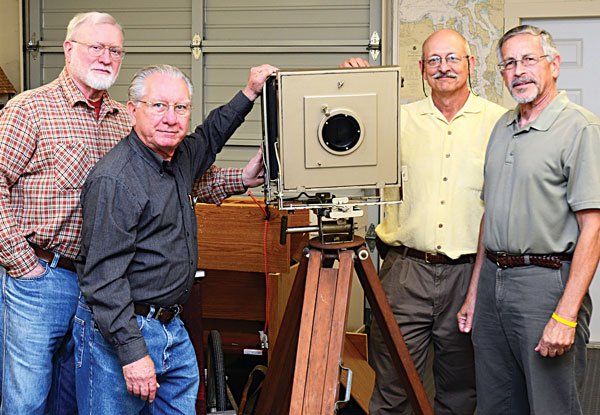by Renee Mizar
MAC Communications Coordinator
The Museum & Arts Center in the Sequim-Dungeness Valley is stepping through the looking glass into photography’s past in an upcoming interactive presentation by a trio of professional photographers.
Robert Schlechter, DJ Bassett and Ted Cordua present “Then & Now: 8×10 View Camera Photography,” from 10 a.m.-1 p.m. Thursday, Sept. 29. The group will meet at the Dungeness Schoolhouse, 2781 Towne Road, and then, weather permitting, travel to the Dungeness Pioneer Cemetery for some choice photographic viewpoints.
Using an 8-inch by 10-inch view camera recently donated to the MAC by Charlotte Watts and photographic prints from the same camera donated by Cordua, the trio will duplicate a scene taken with the camera, allowing participants to view the same scene past and present.
The camera was built by area photographer Albert Douglas Blackstone Jr., some of whose 8-inch by 10-inch photographic prints and negatives of Sequim-Dungeness Valley landscapes, barns and other scenery taken with the camera recently were donated to the MAC by Cordua.
The presentation also will feature special guest V. Keith Fleming Jr. of Port Townsend, who will be on hand to talk about his own 8-inch by 10-inch Deardorf view camera, as well as to discuss view camera controls and techniques.
“The event is a rare chance to see large format 8 by 10 cameras in use and be able to view an image on the ground glass of the camera,” said Schlechter, who has been the MAC’s photo archivist for several years. “Photographers of all levels of expertise should bring their camera of choice along to see how well they can duplicate the scene with their cameras.”
Program fees are $10 for MAC members and $15 for nonmembers; fees help support continued MAC programming. Advance registration is encouraged, though not required, through the MAC Exhibit Center, 175 W. Cedar St. in Sequim. Credit card payment is accepted through the exhibit center, with cash or check payment accepted at the door on program day.
“This class is not for intensive photographic instruction, but it is to get a sense of the historical, traditional film-camera techniques,” said Bassett, the MAC’s executive director. “An 8 by 10 view camera uses an 8- by 10-inch piece of film. The 80 square inches of information that’s able to be recorded is massive and the reason people hauled those huge cameras around.”
This program marks the first of several history, genealogy, art and culture-related presentations in the MAC’s fall programming schedule. For more information about upcoming MAC programming, visit www.macsequim.org or call the MAC Exhibit Center at 683-8110.



